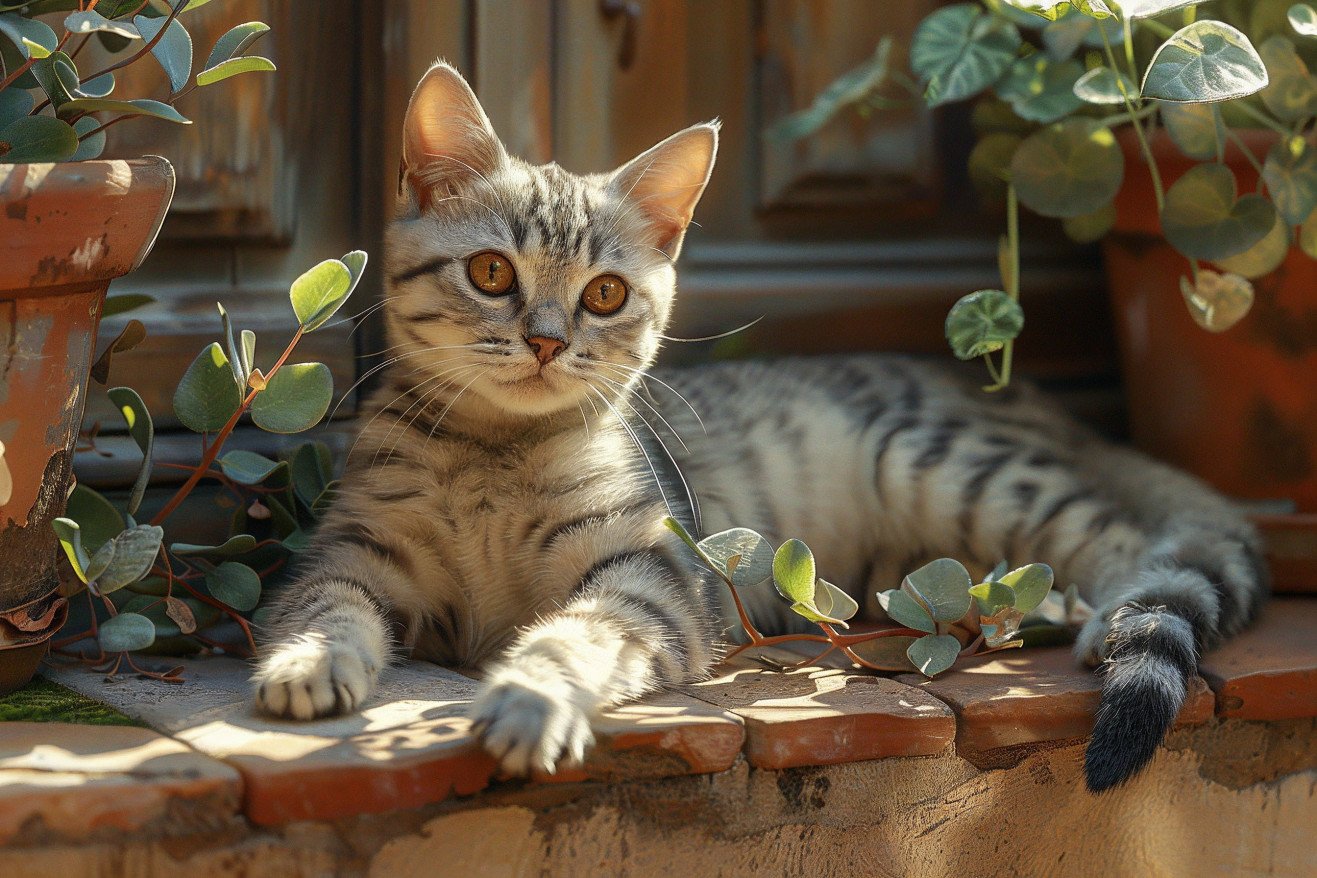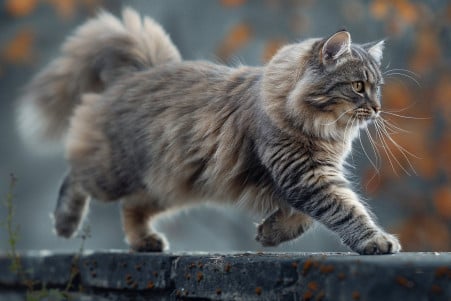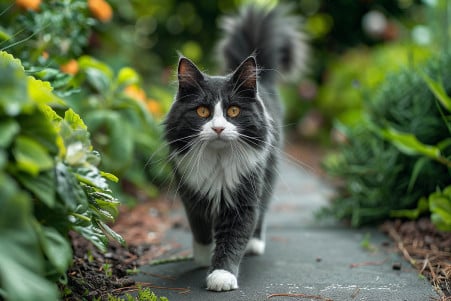Cat Tail Wagging While Lying Down: What Does It Mean?
1 March 2024 • Updated 29 February 2024

Cats are known for their subtlety in communication, and their tail wagging while lying down is no different. A cat’s tail wag while lying down can mean a number of things, from happiness to annoyance to focus. It indicates the cat’s state of awareness or arousal, and it’s an important part of how cats communicate.
In this deep dive into the complex world of cat behavior, we draw on research from animal ethology, veterinary science, and cognitive biology to better understand the many factors that could lead to a cat wagging its tail while lying down. By doing so, we hope to offer a more complete picture of the physiological and psychological influences that play a role in this fascinating part of cat behavior.
What does it mean when cats wag their tails while lying down?
Understanding Cat Tail Language
Cats use their tails to express a wide range of emotions, and learning to read these signals can help improve your relationship with your pet.
According to PetMD, a cat that holds its tail high is showing sociability and confidence, while a cat that tucks its tail between its legs is feeling scared or in pain. Meanwhile, a study from the University of Southampton found that cats are more likely to approach an unfamiliar object with their tails up.
Of course, the way a cat moves its tail is just as important as the position it holds it in. As Rover.com points out, while dogs wag their tails when they’re happy, cats wag their tails when they’re irritated. For instance, a cat that’s lying down and wagging its tail is either intently focused or slightly annoyed, depending on the circumstances.
Unfortunately, there are many myths surrounding cat tail language. For example, many people believe that cats only wag their tails when they’re angry, which is an oversimplification of their tail language. According to Purina, a low flick of a cat’s tail can indicate that it’s unhappy, while a quiver at the end of its tail is a sign of excitement.
By learning to recognize these subtle signs, we can better understand and meet our cats’ needs. After all, it’s the combination of a cat’s tail position, the speed at which it moves its tail, and the circumstances in which it moves its tail that determines what it’s trying to communicate. In this way, cat tail language is as nuanced and complex as any spoken language.
The Complex Anatomy of a Cat’s Tail
The anatomy of a cat’s tail is a wonder of nature, made up of a complex combination of bones, nerves, and muscles. According to Kritter Kommunity, as much as 10% of a cat’s total bone structure is in the tail, which is primarily made up of a series of small vertebrae called the caudal vertebrae.
These vertebrae give the tail its flexibility and range of motion, which is essential for the tail’s role in balance and communication.
The neurological control of the tail is just as complex. A study published on PubMed explains that neurological signals from the brain cause the tail muscles, including the M. sacrocaudalis and M. coccygeus, to cooperate to control the tail’s position and movement.
These muscles allow the tail to move in a variety of directions, which is only possible because of the tail’s complex neuro-muscular system. This system enables cats to communicate a wide range of emotions and messages with their tails.
Injuries to the tail can be particularly impactful because of the tail’s neurological importance. Catster explains that when a cat’s tail is injured, it can result in nerve damage that not only impacts the cat’s ability to move their tail but can also affect their balance and control over their bowels and bladder.
This shows how the tail’s anatomy and neurology work together to enable cats to communicate and why it’s so important to handle cats with care to avoid tail injuries.
Understanding the Emotion the Tail Movement Conveys
Cats use their tails to express their emotions, and the way they move their tails can help you understand how they’re feeling. Dr. Elizabeth Colleran worked with the American Association of Feline Practitioners to create a poster that shows the different ways cats use their bodies and tails to communicate.
It includes a variety of tail positions and movements. For example, a cat lying down with a tail that’s twitching side to side is concentrating or slightly annoyed, while a cat with a tail that’s moving quickly side to side is agitated or afraid.
The role of body posture in emotional expression is also important. Colleran suggests that people consider the cat’s entire body language, including the position of their ears and whiskers and their respiratory rate, to understand what their tail movement is telling them.
A cat that’s lying down with a relaxed body and a tail that sways side to side is typically happy, while a cat that’s lying down with a stiff body and a tail that thumps side to side is likely to be upset or annoyed.
A study published in PMC by Dr. Marcello Siniscalchi found that cats can use visual and auditory cues to recognize human and conspecific emotions, which suggests that tail wagging is part of a larger system of communication. This means that a cat’s tail wagging, even when it’s lying down, isn’t just a reflex but is part of a more complex system of emotional expression.
The RSPCA also notes that the context and environment in which a cat is wagging its tail are important to consider when interpreting what the tail movement means, which suggests that there’s more to learn about how a cat’s environment impacts its communicative tail language.
Cat Behavior & Environment
The environment in which a cat lives has a major impact on the way that it expresses itself, including through tail movements.
Living indoors is a completely different experience for a cat than living outdoors, and this will impact the way that cats use their tails to communicate.
A study by Judith L. Stella published in PMC found that environmental stressors, including living in a small space and a lack of environmental enrichment, can lead to behavioral problems, including changes in tail communication.
On the other hand, a study by Anna Scandurra et al. published in Animals (Basel) and summarized in PMC found that indoor/outdoor cats showed less persistence in problem-solving tasks, which may indicate a lower stress response and lead to differences in tail communication.
The way that humans interact with cats and the presence of other animals also impact a cat’s behavior. Cats that are well-socialized or live in an enriched environment with positive human contact are less likely to show behavioral problems, including stress-related tail wagging.
Territoriality is also a big factor, as tail movements can be used to show territorial claims or challenges, especially in multi-cat households or when outdoor cats encounter other cats in their territory.
Because environmental factors have such a big impact on a cat’s tail communication, understanding these factors can help people better understand a cat’s body language and overall well-being. Therefore, tail wagging while lying down can be seen as a result of both internal states and external environmental stimuli, which leads to a discussion of sensory perception and its impact on feline behavior.
The Senses That Drive Tail Movements in Cats
Cats have highly developed sensory systems that impact their behavior, including their tail movements. For example, a cat’s sense of smell is about 40 times more sensitive than a human’s sense of smell, and it helps cats understand and interact with their world.
The Texas A&M College of Veterinary Medicine & Biomedical Sciences explains that a cat’s sense of smell, which is supported by a special organ that detects pheromones, provides cats with a lot of information that could lead to a tail movement.
In addition, cats have a keen sense of hearing that allows them to hear high-frequency sounds like a mouse’s squeak. A cat’s sense of hearing could lead to a tail movement, as well, because cats may move their tails in response to sounds that make them feel alert or stressed.
Cats also rely on their sense of touch to understand the world around them, and their whiskers are a key part of this sense. Animal Wellness Magazine explains that a cat’s whiskers are touch receptors that provide cats with important information about their environment. Whiskers can pick up on even the smallest changes in a cat’s environment, and this information can lead to tail movements as cats move through their environment.
These senses—smell, hearing, and touch—work together to help cats respond to the world around them with a variety of tail movements. Whether a cat’s tail moves in response to a new smell, a sudden sound, or a change in the air, the movement is part of a bigger sensory picture that helps us understand cat communication better.
The Bottom Line: What Cat Tail Twitching While Lying Down Means
Throughout this article, we have delved into the many factors that can influence the behavior of cat tail twitching while lying down, including physiological structure, neurology, emotions, environment, and sensory perception. This behavior with various aspects is a reflection of the complex and nuanced world of feline communication, with each tail twitch, swish, or flick carrying a different message.
Tail movements are an important way for cats to express their emotions, letting others know whether they are feeling happy, focused, annoyed, or alert. The anatomy and neurology of the tail make for a wide range of expressions, but environmental factors also play a role in how these expressions are used. Cats’ heightened senses also allow them to respond to stimuli, which they often do through the subtle language of tail wagging.
Understanding these subtleties is important for pet parents who want to have a healthy relationship with their cats. By understanding the many factors that can influence tail movements when cats are lying down, we can make the most of our interactions and deepen our connection with our cats.
As we wrap up this exploration, it’s important to remember that each tail wag should be seen as a word in the silent yet expressive language of cats, and we should listen and learn accordingly.


